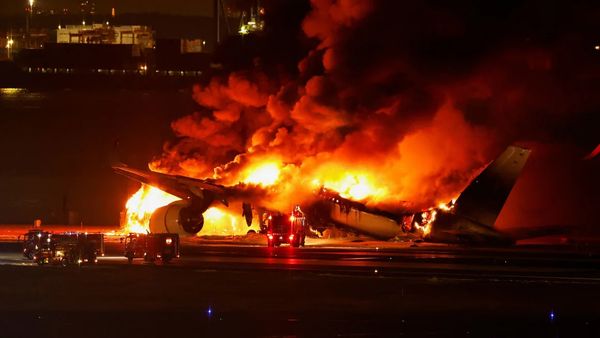A Japan Airlines Airbus A350-900 aircraft caught on fire after landing on a runway at Tokyo Haneda Airport (HND) on January 2. The A350 had flames inside that were seen coming out of the plane's windows and below the aircraft. The plane collided with an aircraft from the Japan Coast Guard that was on the runway at the same time. All 379 passengers and crew onboard were safely evacuated, with no deaths or life-threatening injuries reported on the Japan Airlines flight. Five people died on the Coast Guard plane.

Video footage shared online shows multiple fire trucks on the scene to deal with the smoke and flames. The aircraft was landing normally until it burst into flames, similar to a large explosion. The A350 stopped on the runway with the passengers using emergency slides to escape the aircraft. The firefighters remained on the scene to extinguish the flames.

A Japan Airlines spokesperson told local media: "We are currently assessing the extent of the damage." Haneda Airport temporarily suspended flights while the authorities continue investigating how the incident could have occurred. As of 7:50 p.m. local time, the A350 is still ablaze after approximately two hours, with the aircraft almost completely burnt down. It was later revealed that one person onboard the Coast Guard plane escaped, while the other five passengers died.

Japan Airlines released a statement about the cause of the incident later on January 2. The airline said that the A350's in-flight announcement system malfunctioned during the evacuation, so crew members used megaphones to give instructions. Although the flight received permission to land, flight control might have disagreed over more specific details. The aircraft did not have any engine or technical problems.
.jpg)
Japan Airlines flight JL 516 departed from New Chitose Airport (CTS) in Sapporo at 4:00 p.m. local time and was scheduled to arrive in Tokyo at 5:40 p.m. This route operates daily using an Airbus A350-900 aircraft. There is strong demand for travel between Sapporo and Tokyo since Japan Airlines operates 16 daily flights connecting the two cities. Passengers can also travel between Sapporo and Tokyo-Haneda on Air Do, All Nippon Airways (ANA), and Skymark Airlines. Furthermore, ANA and three other Japanese airlines offer flights between Sapporo and Tokyo's other airport, Narita International Airport (NRT).
This incident comes after a 7.6-magnitude earthquake shook western Japan on New Year's Day, killing at least 48 people as of January 2. The Coast Guard aircraft was planning to carry food to the affected communities. Many Japanese carriers, including ANA and Japan Airlines, canceled flights servicing airports in the affected regions. Noto Airport (NTQ) in Ishikawa Prefecture was closed to all passenger traffic on January 2, exacerbating the challenges of evacuating people from the area and providing humanitarian aid. The earthquake is unlikely to affect tourism since many of Japan's tourist hotspots, including Tokyo, Mount Fuji, and Kyoto, are on the country's east coast.

Japan reopened its borders to tourists in October 2022 after more than two years of restrictions due to the COVID-19 pandemic. The country is getting closer to pre-pandemic tourism levels since 20 million international travelers visited Japan from January to October 2023, compared to 31.8 million international tourists in 2019. Japan Airlines is accommodating this increased demand by introducing new routes and ordering new aircraft. The carrier's most recent change is the introduction of an Airbus A350-1000 plane on its route between HND and John F. Kennedy International Airport (JFK).
Citation C550 Fireball: Greg Biffle and Five Others Killed in Failed Emergency Landing at KSVH » Southwest and Turkish Airlines Unveil 2026 Partnership » NTSB: Maintenance Error Led to Citation CJ4 Gear Collapse in Baton Rouge »
Comments (0)
Add Your Comment
SHARE
TAGS
NEWS Japan Tokyo HND Japan Airlines Fire Incident Airbus A350 A350-900RECENTLY PUBLISHED
 The Top 5 Longest Flights in the World
Technology continues to transform the way we live, work, and connect. Few industries embody this more than air travel, which has effectively shrunk the world in recent years. Journeys that would have once seemed impossible can now be completed in mere hours. Here's a look at the World's Top 5 flights, ranked by distance.
INFORMATIONAL
READ MORE »
The Top 5 Longest Flights in the World
Technology continues to transform the way we live, work, and connect. Few industries embody this more than air travel, which has effectively shrunk the world in recent years. Journeys that would have once seemed impossible can now be completed in mere hours. Here's a look at the World's Top 5 flights, ranked by distance.
INFORMATIONAL
READ MORE »
 Top 5 Unique Gifts for Pilots & Aviation Lovers Under $50
Discover five budget-friendly aviation gifts for under $50, ranging from stylish polarized aviator sunglasses and airplane pattern ties to practical VFR sectional flashcards. This curated list offers the perfect mix of professional utility and industrial decor for every pilot and flight enthusiast.
STORIES
READ MORE »
Top 5 Unique Gifts for Pilots & Aviation Lovers Under $50
Discover five budget-friendly aviation gifts for under $50, ranging from stylish polarized aviator sunglasses and airplane pattern ties to practical VFR sectional flashcards. This curated list offers the perfect mix of professional utility and industrial decor for every pilot and flight enthusiast.
STORIES
READ MORE »
 Memphis at Midnight: Inside FedEx's Global Superhub
When considering major hub airports in the United States, few might think of Memphis International Airport (MEM). This facility, which is only the second busiest in Tennessee based on passenger volumes, might not boast an impressive flight schedule from passenger airlines. However, across the airfield from Memphis' passenger terminal, FedEx has turned the airport into a critical cargo superhub. In fact, between the hours of 10:00 PM and 5:00 AM, Memphis becomes the busiest airport in the world.
INFORMATIONAL
READ MORE »
Memphis at Midnight: Inside FedEx's Global Superhub
When considering major hub airports in the United States, few might think of Memphis International Airport (MEM). This facility, which is only the second busiest in Tennessee based on passenger volumes, might not boast an impressive flight schedule from passenger airlines. However, across the airfield from Memphis' passenger terminal, FedEx has turned the airport into a critical cargo superhub. In fact, between the hours of 10:00 PM and 5:00 AM, Memphis becomes the busiest airport in the world.
INFORMATIONAL
READ MORE »



